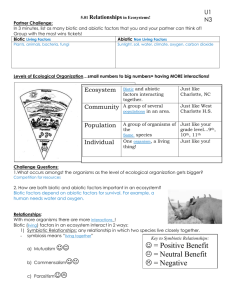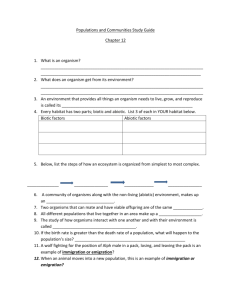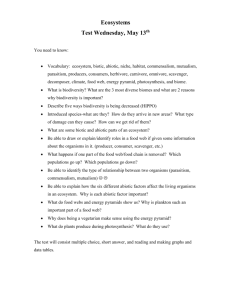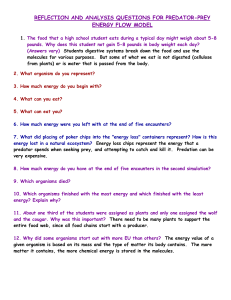What I need to know about Nucleic Acids, Osmosis and Diffusion
advertisement
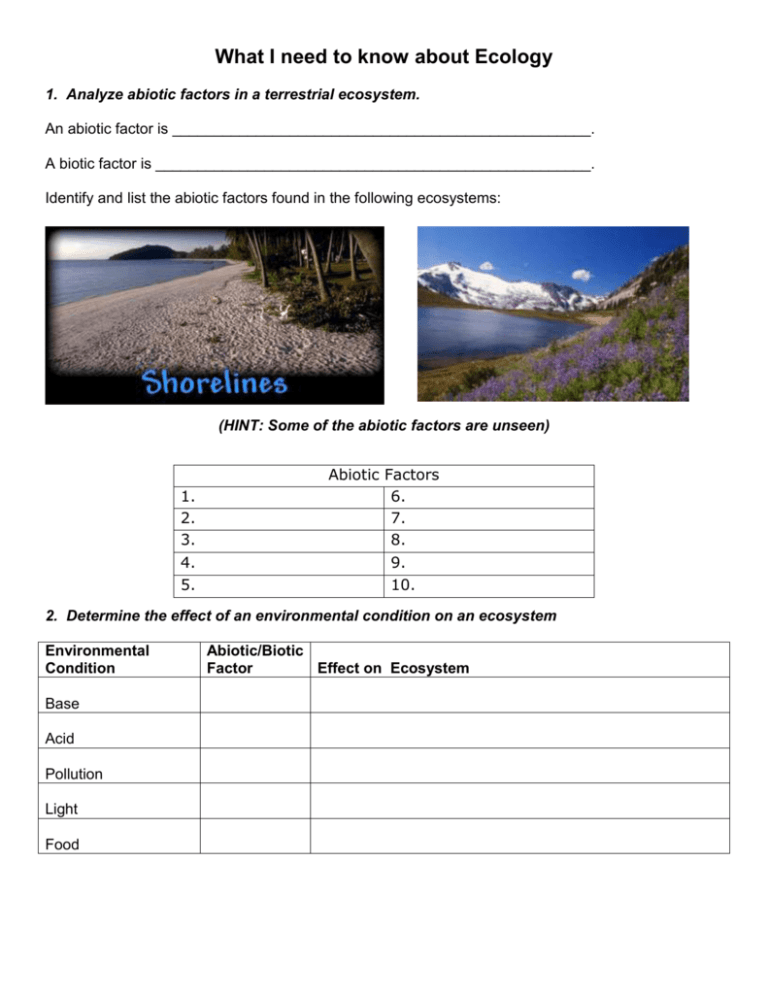
What I need to know about Ecology 1. Analyze abiotic factors in a terrestrial ecosystem. An abiotic factor is __________________________________________________. A biotic factor is ____________________________________________________. Identify and list the abiotic factors found in the following ecosystems: (HINT: Some of the abiotic factors are unseen) 1. 2. 3. 4. 5. Abiotic Factors 6. 7. 8. 9. 10. 2. Determine the effect of an environmental condition on an ecosystem Environmental Condition Base Acid Pollution Light Food Abiotic/Biotic Factor Effect on Ecosystem 3. Analyze interactions between predator/prey. Using the picture above, identify the predator and the prey in the space provided. Predator _____________ Prey ________________ In a predator/prey relationship, does the prey control the predator or does the predator control the prey? Why? _____________________________________________ _____________________________________________ _____________________________________________ _____________________________________________ _____________________________________________ Using the graph from above, describe what happens to the population of predators as the population of prey increases. ________________________________________________________________________________ ________________________________________________________________________________ ________________________________________________________________________________ 4. Classify symbiotic relationships Name that relationship! Is it mutualism, commensalism, parasitism? A honeybee gets to eat the nectar from a flower. The dandelion uses the bee to spread its pollen to another flower. What type of relationship do these two organisms share? _____________ An American Robin builds its nest in a Red Maple tree so that it may have a home to take care of its young. The maple tree is unaffected by the presence of the American Robin and its nest. What type of relationship do these two organisms share? _________________________________ A deer tick makes its home on a White-tailed Deer. The tick is able to get food from the deer without killing. Although the deer is not killed, it is harmed by losing blood to the tick, and possibly by getting an infected wound. What type of relationship do these two organisms share? _________________________________________ The oxpecker (a kind of bird) and the zebra share a symbiotic relationship. The Oxpecker lands on the zebra and eats the ticks and other parasites that live on their skin. The oxpecker gets food and the zebra get pest control. How does this relationship show mutualism? _______________________________________________ _______________________________________________ Barnacles are crustaceans whose adults are sedentary (do not move around). The motile (moving) larvae find a suitable surface, in this case a whale, and then undergo a metamorphosis (change) to the sedentary adult form. The barnacle benefits by finding a habitat where nutrients are available. In other words, the whale provides transportation to various new food sources. The presence of barnacle populations on the whale does not appear to hamper or enhance its survival. How does this relationship show commensalism? ______________________________________________ ______________________________________________ The lamprey is a primitive fish that attaches to the bodies of native fish and feeds on their body fluids. This often leads to the death of the native fish. How does this relationship show parasitism? _________________________________________________________ _________________________________________________________ Competition Use the word bank to complete the following: Water, food, light, never, fighting, resource, effect, species, nesting, supply, Competition is when two _________________ use the same ______________. Some examples of the types of resources for which species compete are: __________, ___________ sites, living space, ________, mineral nutrients, and _________. This competition occurs when there is a shortage in the ___________. Competition between species does not always involve ________________. Some species actually __________ encounter each other. Their interaction may only be their _________ on the available resources. The interaction between a spruce tree and a hemlock tree, both of which require nitrogen from the soil, is an example of a. mutualism b. commensalism c. succession d. competition 5. Illustrate the movement of water, carbon, and nitrogen within an ecosystem. The water cycle shows the movement of water between ______________ systems and the __________________. On Earth, water cycles through the atmosphere, oceans, land, and organisms. By what process does most of the water in plants return to the environment? a. b. c. d. evaporation from the roots condensation on the leaves transpiration: evaporation from the leaves diffusion from the roots The Nitrogen Cycle What organism is responsible for converting nitrogen into a form that plants can use? ____________________ What human factors increase nitrogen levels in the environment? 1. __________________ 2. __________ NOTE: High levels of nitrogen lead to algal blooms, which lower the oxygen level in environments like the Chesapeake Bay. The Carbon Cycle What two processes are involved in the cycling of carbon? 1. ________________________ 2. ________________________ 6. Identify the interrelationships among organisms in an ecosystem. From this ocean food web, locate and list two food chains. 1._____________________________________ _______________________________________ 2.______________________________________ _______________________________________ Using the information provided by the oceanic food web, complete the chart. Organism Trophic Level (Producer/Primary Consumer/Secondary Consumer/Top Consumer) What would happen to the other organisms in the food web if: a. the killer whale became extinct b. the shrimp became overpopulated 7. Illustrate relationships among organisms. Why is the first trophic level (the producers) the largest level in the energy pyramid. ______________________________________________ ______________________________________________ ______________________________________________ Primary consumers are herbivores, carnivores, omnivores. (circle one) The numbers on the side of the energy pyramid represent ________________________________ Why do the numbers decrease from 1000 to 1 as the pyramid rises. ________________________________________________________________________________ ________________________________________________________________________________ 8. Describe Succession. Briefly explain what is happening in the diagram. ____________________________________ ____________________________________ ____________________________________ ____________________________________ ____________________________________ Lichens that colonize bare rocks are an example of a pioneer species (first species to live in an environement). In which environment would a pioneer species be most successful? a. b. c. d. an old-growth deciduous forest. a hillside that has been cleared by a forest fire. a mountain meadow after the spring snowmelt. a grassland that has established itself on the site of an old farm. 9. Explain how natural and manmade changes in the environment affect individual organisms and the dynamics of populations. Complete the chart below: Natural and Manmade Changes Depletion of food Destruction of habitats Disease Natural disasters Pollution Population increase Urbanization Description of Environmental Impact


